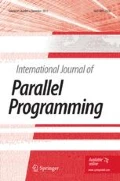Abstract
The conversion algorithms for two classes of tree transducers, i.e., simple generalized syntax-directed tree translation (SGSDTT) and generalized finite state transformation (GFST), are proposed. A top-down backtrack parsing algorithm for a GFST is presented. The minimum distance structure-preserved error-correcting tree automaton is also extended to be a parser for SGSDTT. Finally, the tree transducers are applied to modeling and analysis of human motion.
Similar content being viewed by others
References
M. G. Thomason and R. C. Gonzalez, “Syntactic recognition of imperfectly specified patterns,”IEEE Trans. Comput.,C24:93–85 (1975).
M. G. Thomason, “Stochastic syntax-directed translation schemata for correction of errors in context free languages,”IEEE Trans. Comput.,C24:1211–1216 (1975).
T. I. Fan and K. S. Fu, “A syntactic approach to time-varying image analysis,”Computer Graphics and Image Processing 11:138–149 (1979).
T. I. Fan and K. S. Fu, “Tree translation and its application to traffic image scene analysis,”Proc. IEEE Conf. on Pattern Recognition and Image Processing, 184–188 (1981).
T. I. Fan and K. S. Fu, “A syntactic method for time-varying pattern analysis,” School of Electrical Engineering, Purdue University, TR-EE 81-10 (May 1981).
A. V. Aho and J. D. Ullman, “Properties of syntax-directed translations,”J. Comput. System Sci.,3:319–334 (1969).
A. V. Aho and J. D. Ullman, “Syntax directed translations and the push-down assembler,”J. Comput. Sustem Sci.,3:37–56 (1969).
A. V. Aho and J. D. Ullman, “Caracterizations and extensions of push-down translations,”Math. Syst. Theory,5:95–96 (1971).
A. V. Aho and J. D. Ullman, “Translations on a context free grammar,”Information and Control,19:439–475 (1971).
J. Thatcher, “Generalized sequential machines,”J. Comput. System Sci.,4:339–367 (1970).
W. Rounds, “Mappings and grammars on trees,”Math. Syst. Theory,4:257–287 (1970).
B. S. Baker, “Generalized syntax directed translation, tree transducers, and linear space,”SIAM J. Comput.,7(3):376–391 (1978).
B. S. Baker, “Tree transducers and tree languages,”Information and Control,37:241–266 (1978).
J. Engelfriet, “Bottom-up and Top-down Tree Transformations—a comparison,”Math. Syst. Theory,9(3): 198–231 (1975).
W. S. Brainerd, “Tree generating regular systems,”Information and Control,14:217–231 (1969).
Y. C. You and K. S. Fu, “Syntactic shape recognition using attributed grammars,” School of Electrical Engineering, Purdue University, TR-EE-78 38 (September 1978).
J. W. Tai and K. S. Fu, “Semantic syntactic-directed translation for pictorial pattern recognition,” School of Electrical Engineering, Purdue University, TR-EE 81-38, Oct. 1981.
Q. Y. Shi and K. S. Fu, “Parsing and translation of (attributed) expansive graph languages for scene analysis,” School of Electrical Engineering, Purdue University, TREE 82-1, Jan. 1982.
S. Y. Lu and K. S. Fu, “Structure-preserved error-correcting tree automata for syntactic pattern recognition,”Proc. 1976, IEEE Conf. Decis. Control, (1976).
N. I. Badler, O'Rourke, and H. Toltzis, “A spherical representation of a human body for visualizing movement,”Proc. of the IEEE,67(10):1397–1403 (1979).
T. W. Calvert, J. Chapman, and A. Patla, “The integration of subjective and objective data in the animation of human movement,”Computer Graphics,14(3): 198–203 (1980).
N. I. Badler and S. W. Smoliar, “Digital representation of human movement,”Computing Survey,11(1): 19–38 (1979).
N. I. Badler, J. O'Rourke, and B. Kaufman, “Special problems in human movement simulation,”Computer Graphics,14(3): 189–197 (1980).
N. J. Badler, J. O'Rourke, S. Platt, and M. A. Morris, “Human movement understanding: a variety of perspectives,”IEEE Proc. 1st. Nat'l Conf.Artificial Intelligence, 35–37 (1980).
J. O'Rourke and N. I. Badler, “Model-based image analysis of human motion using constraint propagation,”IEEE Trans. Pattern Anal. Machine Intell.,2(6):522–536 (1980).
R. F. Rashid, “Toward a system for the interpretation of moving light display,”IEEE Trans. Pattern Anal. Machine Intell.,2(6):574–581 (1980).
J. A. Webb and J. K. Aggarwal, “Visual interpreting the motion of objects in space,”IEEE Computer,4(8):40–46 (1981).
J. A. Webb, “Static analysis of moving jointed objects,”IEEE Proc. 1st Nat'l Conf. Artificial Intelligence, 35–37 (1980).
N. S. Chang and K. S. Fu, “Parallel parsing of tree languages for syntactic pattern recognition,”Pattern Recognition,11(3):213–222 (1979).
Author information
Authors and Affiliations
Additional information
This work was supported by the NSF Grant IST 79-18884.
Rights and permissions
About this article
Cite this article
Lin, WC., Fu, KS. Conversion and parsing of tree transducers for syntactic pattern analysis. International Journal of Computer and Information Sciences 11, 417–458 (1982). https://doi.org/10.1007/BF00996819
Received:
Revised:
Issue Date:
DOI: https://doi.org/10.1007/BF00996819
Key words
- Syntactic pattern recognition
- tree
- top-down tree transducer
- bottom-up tree transducer
- generalized syntax-directed translation
- generalized syntax-directed tree translation
- generalized finite-state transformation
- tree grammar
- top-down backtrack parsing
- minimum-distance structure-preserved error-correcting parser
- human motion modeling
- grammatical inference
- motion analysis




